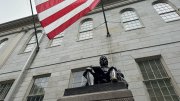Following two years of high investment returns on endowment assets, the Harvard Corporation has approved an increase in funds distributed to support University operations in fiscal year 2006, beginning July 1 -- but with a new twist. During the current fiscal year, ending June 30, endowment funds distributed for operations are projected to increase by 4 percent (to about $840 million). The new formula holds to that 4 percent rise for 2006, but adds an additional sum of up to 4 percent more in support of "agreed-upon spending plans for goals identified by Larry Summers and the deans," according to financial vice president Ann E. Berman.
Harvard's schools enjoyed the benefits of large endowment distributions in the years following the sustained high investment gains that peaked in 2000, and the conclusion of the University Campaign, the $2.6-billion fundraising drive that ended in 1999. Today, such distributions account for about 31 percent of University revenues. But in the wake of negative investment returns in fiscal years 2001 and 2002, and as President Lawrence H. Summers began laying out new priorities -- with expensive commitments to science, Allston development, and other goals -- the Corporation tightened the spigot.
Investment performance has lately roared back: endowment investments appreciated 12.5 percent and 21.1 percent, respectively, in fiscal years 2003 and 2004. Hence the opportunity now, Berman said, "to make sure we make progress on the priorities we've identified." The kind of targeted use of extra resources proposed now has been tried in some of the faculties in the past, she noted, but not on so wide a scale.
What is distinctive here is central direction of the planning: the priorities that qualify for the additional spending are to be explicitly negotiated and agreed to by the president and each dean. Moreover, a report on the use of the additional payout is to be provided to the Corporation, which wants to be assured that the funds are applied to priority uses. What might such uses be? The sum involved -- $35 million to $40 million of added annual spending -- "should enable significant focus on priorities," Summers said in an interview. Among them he listed financial aid, faculty growth especially in the sciences, and the Medical School's systems-biology program (see "Seeing Biological Systems Whole").
Pending his discussions with faculty members and Summers, Faculty of Arts and Sciences (FAS) dean William C. Kirby remained general about eligible commitments, saying only that they had to be "new in scope, new in focus." FAS has as much as an extra $12 million at stake for use next year -- enough to make a difference in advancing goals identified in his annual letter (see "The College Reconfigures") such as international study, expanded graduate-student fellowships, or emerging fields of scientific research.




